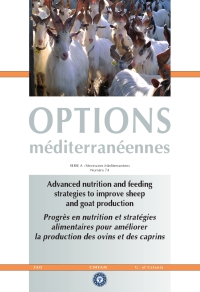| Article précédent | p. 351-357 | Article suivant |
Effect of stocking rate on selective behaviour and milk production of Girgentana goats grazing a ryegrass and berseem clover mixture
This experiment aimed to examine the effect of stocking rate (SR) on selectivity, dry matter (DM) intake and milk production of Girgentana goats grazing on a sward of ryegrass (RG) and berseem clover (BC) mixture. The experiment involved 21 goats at 130±6 d of lactation divided into 3 homogeneous groups. From 9th April, for 87 d, each group grazed (9.00 am to 4.00 pm) on a sward plot with a different surface (972, 1458, 1944 m2), according to a high (HSR, 72 goats/ha), medium (MSR, 48 goats/ha) and low SR (LSR, 36 goats/ha). All the goats were fed 500 g head/d of barley meal. Weekly, sward biomass, herbage selected by goats and individual milk yield were measured and sampled. The DM intake and digestibility and diet botanic composition of grazing goats were assessed by the n-alkane method. Grazing at HSR was suspended 25 d before MSR and LSR (62 vs 87 d), due to the low biomass availability. During the 62 d of contemporary grazing, biomass availability was lower at HSR (P=0.001). The BC was the dominant species in each plot, while the HSR led to a low presence of RG (P=0.001). SR affected botanic composition of selected herbage: the incidence of the more palatable RG decreased (P=0.001) with SR increase. DM intake and digestibility of forage at pasture increased (P=0.001) from HSR to LSR, resulting in an improved milk yield (P=0.001), without any changes in milk composition. Whereas the HSR gave the lowest total milk yield per goat, grazing at MSR produced the highest milk amount per ha during the whole grazing period.
On a étudié les effets du chargement (SR) sur la sélectivité, la consommation de matière sèche (DM) et la production laitière de chèvres de race Girgentana pâturant une prairie de Lolium multiflorum (RG) et Trifolium alexandrinum (BC). 21 chèvres à 130±6 j de lactation ont été réparties en 3 lots homogènes. A partir du 9 avril, pendant 87 j, chaque groupe a pâturé de 9h00 à 16h00 sur des parcelles de différente surface (972, 1458, 1944 m2), selon un chargement élevé (HSR, 72 chèvres/ha), moyen (MSR, 48 chèvres/ha) et bas (LSR, 36 chèvres/ha). Tous les animaux recevaient 500 g/j de farine d'orge. La biomasse des parcelles, l'herbe sélectionnée par les chèvres et la production individuelle de lait ont été mesurées et échantillonnées une fois par semaine. La consommation de DM, la digestibilité et la composition botanique de la ration au pâturage ont été évaluées par la méthode des n-alcanes. Pour le lot HSR le pâturage a été arrêté 25 j avant les autres (62 vs 87 j), en raison de la basse disponibilité de biomasse. Pendant ces 62 j de pâturage, la disponibilité de biomasse a été plus limitée pour le lot HSR (P=0,001). Le BC a été l'espèce dominante dans toutes les parcelles. Le HSR a conduit à une présence réduite de RG (P=0,001). Le SR a influencé la composition botanique de l'herbe sélectionnée : l'incidence du RG a diminué (P=0,001) en augmentant le SR. La consommation de DM et la digestibilité du fourrage au pâturage ont augmenté (P=0,001) du HSR au LSR; cela a causé une augmentation de la production laitière (P=0,001), sans modifier la composition du lait. Le lot HSR a donné la plus basse production de lait par chèvre et le lot MSR a eu la production la plus élevée par ha pendant toute la période de pâturage
- [ Afficher ]
- [ Télécharger ]
- [ Exporter la citation ]
Vous pouvez télécharger la citation au format :
- [ Imprimer ]
-
Mots-clés
CHEVRE, CONSOMMATION ALIMENTAIRE (ANIMAUX), EXPERIMENTATION, INTENSITE DE PATURAGE, PATURAGE, PRODUCTION LAITIERE, TAUX DE CHARGECiter cet article
Bonanno A., Di Grigoli A., Alicata M.L., Tornambè G., Avondo M., Pagano R., Giambalvo D., Stringi L., Di Miceli G. Effect of stocking rate on selective behaviour and milk production of Girgentana goats grazing a ryegrass and berseem clover mixture. In : Priolo A. (ed.), Biondi L. (ed.), Ben Salem H. (ed.), Morand-Fehr P. (ed.). Advanced nutrition and feeding strategies to improve sheep and goat . Zaragoza : CIHEAM, 2007. p. 351-357. (Options Méditerranéennes : Série A. Séminaires Méditerranéens; n. 74). 11. Seminar of the FAO-CIHEAM Sub-Network on Sheep and Goat Nutrition, 2005/09/08-10, Catania (Italy). http://om.ciheam.org/om/pdf/a74/00800401.pdf



